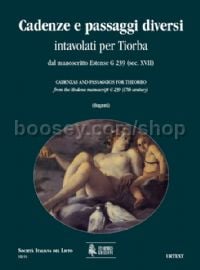Cadenze e Passaggi diversi for Theorbo from the Modena manuscript G 239 (17th century)
Cadenze e Passaggi diversi for Theorbo from the Modena manuscript G 239 (17th century)
* Estimated price converted from UK retail price
This is an edition of the so-called 'Modena tiorba manuscript' which has been the subject of a two articles by Mirco Caffagni (in Italian, in Quadrivium IX, fasc. 1 (1970), and in English, in Journal of the Lute Society of America XII (1979). The manuscript contains songs for solo voice and continuo, not included in this edition, and a section of bass progressions realized in tablature for theorbo in A. The latter are of considerable interest, partly because of their rarity, (the only comparable source surfaced recently in New York) but largely because they are extremely florid yet idiomatic examples of continuo realization.
Bagnati's edition include a detailed introduction with a description of the manuscript and its contents, in Italian only. He recounts Caffagni's hypothesis from the aforementioned articles, that the manuscript was written out by Pietro Bertacchini, a Modenese collector, singer, and player of theorbo and archlute, and that the continuo exercises date from c.1670. Then follows the critical commentary, and a facsimile page.
The exercises range from two-bar cadential realizations to quite extended pas-sages which include many typical bass-line progressions, and vary in difficulty from basic chords to elaborate cadences with slurs, campanellas and running bass divisions. The edition itself include the bass part, tablature (Italian) and a two-stave transcription. All are accurately and clearly laid out, the editorial decisions are sensible (and are tabulated in the commentary anyway) and the transcription not only opens up the edition to players of other instruments, but clearly reveals the voice leadings and inversions for the benefit of theorbists too. Bagnati retains the original order, where the progressions are roughly grouped by key.
There are a few awkward page turns, and both the font and spacing of the tablature could be rather more friendly to the eye, but these are tiny quibbles, and a book of this type should in any case be studied in detail and committed to memory. A must for anyone interested in continuo playing, whether you have a theorbo or not. (Lynda Sayce)




